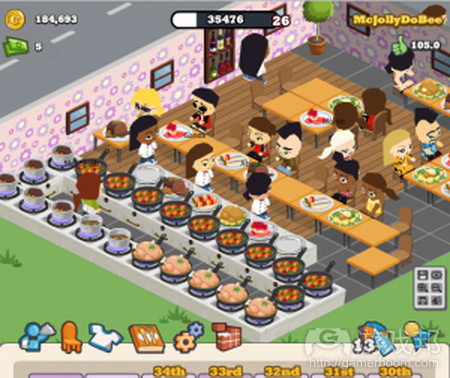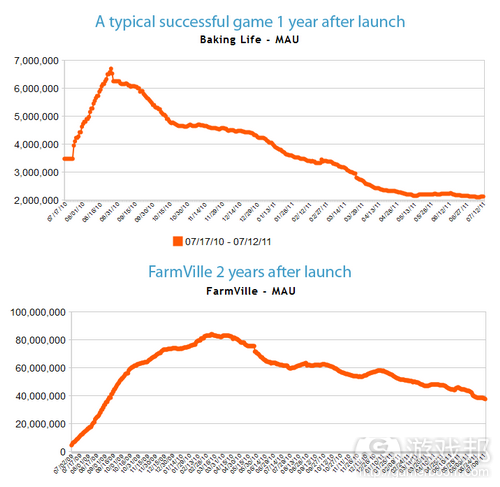老牌Facebook游戏如何提高用户回访率
作者:Tami
要说主流Facebook游戏公司有什么优势,那就是迅速推出新内容,促使持续对游戏玩家感兴趣。要说他们有什么表现糟糕的地方,那就是无法确保游戏内容不会由于添加大量新功能而吓跑新玩家。
成功MMO游戏已顺利解决这个问题。你要如何在游戏末尾推出内容留住玩家,同时确保新玩家不会由于系列尚无法访问内容而倍感受挫?他们或通过规定只有晋升至更高关卡方能访问内容,在游戏初期逐步向玩家引入内容,令其同“内容共同发展”,或确保内容适用各关卡的玩家,不论其处在哪个生命周期点,以此解决问题。
但,若你试着体验某款老牌杰出Facebook游戏(游戏邦注:例如《Cafe World》或《FarmVille》),就会发现其功能非常繁琐。这些作品受惠于平台的病毒式传播功能,及游戏内容简单易学,而大获成功。《FarmVille》不再仅涉及种植、收割庄稼,收集动物和装饰农场。若你现在玩这款游戏,就会发现其内容已开始蕴含农夫市场,合作探索,收集,1亿种可建造物体,搜索松露,创建第二个农场(英国乡村),动物饲料槽,幼儿园,混种树木及养殖羊群,只要你能想到的,里面都有。要新玩家把握如此多内容,着实有些困难。
或者假设你很早前就是《FrontierVille》的忠诚粉丝。间隔很长时间后,你又开始登陆游戏,你会常常收到提示消息,传达游戏新内容。你将无法跟上整个探索过程。你有300个东西需要建造。你需花费好几个礼拜才能够迎头赶上,而到那个时候,你还是慢人一截,因为游戏在此期间又推出许多新元素。
如今不断推陈出新已经成为社交游戏风靡和持续发展的筹码。每款社交游戏的流量生命周期都呈现此发展趋势:MAU(月活跃用户)先发展至顶峰,然后逐渐降低。大型游戏(游戏邦注:主要是Zynga游戏,还有部分EA/Playfish和Crowdstar游戏)试图通过定期推出新内容取悦玩家,避免出现大滑坡。你会发现虽然《FarmVille》逐步呈下滑趋势,但其步伐仍旧缓于正常标准(部分归功于巨额营销预算)。换而言之,这些游戏不仅要继续推出新内容,还要推出新功能,大幅调整核心机制,以掳获玩家芳心。
以下举措能够促使游戏依然能够吸引新用户眼球,保持像刚发行那样带领玩家进入游戏。
定期检测游戏日留存率
你需留心观察新注册玩家隔天的回访情况。能够把握玩家第3天、第5天和第7天的回访情况当然更好。这是获悉新推内容如何影响游戏指南或新用户体验的绝佳途径。
亲自测试新用户体验
注册新Facebook测试帐号,以新玩家身份体验游戏。不要只是浏览游戏指南,亲自体验游戏前10个关卡,观察其呈何种变化趋势。若你做出某些调整,意图改变游戏循环机制或经济模式,内容应在指南清楚体现。
时常进行用户测试以获悉玩家在游戏中的互动情况
用户测试是查看新用户体验情况的有效方式。你可以选择采用内部渠道,或者借助UserTesting.com之类的服务快速获得结果。即便你的新用户体验发行以来未发生改变,现存空间也会发生变化,以致玩家不再理解你的新用户体验(游戏邦注:因为其不同于Facebook标准模式)。或者也许某个你以为不会影响NUX的功能,其实会带来潜移默化的影响,从一开始就破坏你的游戏参数。所以观察用户体验游戏非常重要。
书写游戏说明时需特别考虑新玩家群体
当书写产品要求文件和功能说明时,确保给予新玩家群体特别关照。此功能会在哪个关卡解锁?内容应如何传递给新玩家?引入新功能前,需向玩家呈现那些既有功能?书写新功能说明时,不要只考虑高端游戏玩家。
时常检测回访用户体验
4个月未进行体验的玩家重返游戏会看到何种景象?你会向他们显示多少弹出窗口?他们所有庄稼是否都会死去,秘诀是否都被销毁?游戏是否出现较大变化却未给予相关消息通知?你定希望所有游戏玩家享受到的都是优质体验,不论他们之前是否玩过,他们是否时隔很长时间才回访,或者他们从第1天就持续体验至今。回访体验不应令人生厌,尤其是当你希望回馈回访玩家的时候。找回“已死”用户(游戏邦注:这里指很长时间未进行体验的用户)要比挖掘新用户困难得多。小心呵护回访玩家,不要让他们因回访而受到惩罚。(本文为游戏邦/gamerboom.com编译,如需转载请联系:游戏邦)
Older Facebook games have terrible new/returning user experiences
by Tami
If there is one thing that the leading Facebook game companies have mastered, it’s the quick releasing of an onslaught of new regular content to keep players interested (and paying). If there is one thing that they’re terrible at, it’s making sure that the onramp for new players isn’t daunting because of all of those new rapid-fired features.
This is a problem that successful MMOs in live operations have already figured out. How do you release content at the end game to keep players engaged after vanilla without overwhelming new players with a barrage of content they do not have access to? They’ve solved it by either restricting access to the content until higher level, gradually introducing players to the content at an early level so that they ‘grow into it’, or making sure the content makes sense for people of all levels and regardless of where they are in their player lifecycle.
However, if you try to play an older successful Facebook game such as Cafe World or FarmVille, you will be beaten over the head with features. These games were wildly successful thanks in part to a platform conducive to viral growth, but also because they were so simple to learn and easy to master. FarmVille is no longer just about planting crops, harvesting them, collecting animals, and decorating your farm. If you try to play FarmVille today, it’s now all about Farmer’s Markets, co-op questing, collections, 100 million types of buildable objects, truffle hunting, building out your second farm (English Countryside), animal troughs, nurserys and mixing trees together, sheep breeding, you name it. The list goes on. It is far too overwhelming for a new player to ever catch up.
Or let’s say that you were an avid FrontierVille player back in “the day” (6+ months ago). If you login to the game today after taking a lengthy break, you will be absolutely bombarded with popups telling you about new things. You will be completely behind in quests. You will have 300 things to build. It would literally take you weeks to catch up, and by that time you’ll be behind because of everything that released in those few weeks.
Graphs courtesy of AppData.com
Now, the barrage of features is how social games stay popular and keep growing. Every social game has this natural arc in its traffic lifecycle, where you can see it topping out in MAU (monthly active users) and then tailing off. The biggest games (mostly Zynga titles, but also some of the EA/Playfish games & Crowdstar) have managed to keep releasing new content at a pace that keeps their players happy and minimizes churn. You can see that despite FarmVille’s generally trend down and to the right, they’ve managed to do it at a pace much slower than the norm. (A large marketing budget helps in this regard too..) In other words, it’s absolutely necessary that these games continue to not just release new content but also new features and large changes to the core game to keep their DAUs entertained.
Here are some ideas that social games could do to make sure their game is still appealing to new players and introduces them to the game the same way it did back at launch.
Monitor your one day retention regularly
You should always be keenly aware of the number of newly registered players who end up returning the next day. Even better if you know how many come back within the first 3, 5, 7 days. This is a great way to see if something you have released has negatively (or positively) impacted your tutorial or new user experience.
Test your new user experience personally
Make a new Facebook test account and play the game as a new player. Don’t just run through the tutorial, actually PLAY the game for the first 10+ levels to see how it flows. If you have made changes to impact the game loop or the economy, they should be apparent in a playthrough.
Do user testing every so often to see how players interact with your game
User testing is a very effective way to see how your new user experience works. You can go the in-house route, or just use a service like UserTesting.com that gives you extremely quick results. Even if your new user experience hasn’t changed since launch, the existing space may have changed so that players no longer understand your new user experience because it’s different than the norm on Facebook. Or perhaps a feature that you didn’t think would impact the NUX will actually have a trickle-down effect that destroys your metrics early on. It’s always good to watch people play your game.
Consider new players as a special class of players when writing specs
When writing product requirement docs and feature specs, make sure to have special consideration for new players built in. What level should the feature unlock? How should it be messaged to new players? What existing features should the player be exposed to BEFORE that new feature? Don’t just consider the high level end game players when you’re writing specs for new features.
Monitor your returning player/re-engaged player experience often
What does your game look like to a player who hasn’t played in 4 months? How many popups will you be showing them? Will all their crops be dead and their recipes burned? Will there be a dramatic change to their game with no helpful messaging whatsoever? You want to always make sure that every player’s experience in your game is a good one, regardless if they have never played before, they’re returning after a long hiatus, or have been playing since Day 1 without stopping. This returning experience should not be cumbersome, especially since you want to reward them for coming back. It is much harder to bring back a customer that is “dead” (having not played in some arbitrary amount of time) than it is to find a new customer. Treat returning players like the gold that they are, and never punish them for coming back.(Source:tamibaribeau)
上一篇:社交游戏应具备的8个基本特点











































 闽公网安备35020302001549号
闽公网安备35020302001549号